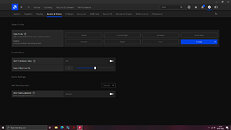
GIGABYTE X670E and X670 AORUS Motherboard Lineup Detailed
GIGABYTE today showed off its upcoming AMD X670E and X670 chipset-based Socket AM5 motherboard lineup for the Ryzen 7000-series "Zen 4" desktop processors due to launch in September. Given AMD's push for PCI-Express Gen 5 connectivity beyond just the PEG slot, the new X670E chipset, with multiple Gen 5 M.2 slots, covers the upper end of the GIGABYTE AORUS motherboard series, with the X670E AORUS Xtreme and the X670E AORUS Master. The lower-end of the lineup is based on the X670, with the AORUS Pro and AORUS Elite tiers.
Both the X670E and X670 offer at least one PCI-Express 5.0 x16 slot (which can be further split into two x8 Gen 5 slots); and at least one PCI-Express 5.0 x4 M.2 NVMe slot wired to the AM5 processor. The X670E is differentiated in having an additional Gen 5 M.2 slot that is wired to the SoC, besides downstream Gen 5 PCIe connectivity from the chipset. The AORUS Xtreme leads the pack with a monstrous 18-phase VRM that uses 105 A DrMOS, an 8-layer PCB, four Gen 5 M.2 slots, the highest-grade onboard audio with ESS-made headphones DAC, AQuantia 10 GbE, WiFi 6E, and a plethora of overclocker-friendly features.
Both the X670E and X670 offer at least one PCI-Express 5.0 x16 slot (which can be further split into two x8 Gen 5 slots); and at least one PCI-Express 5.0 x4 M.2 NVMe slot wired to the AM5 processor. The X670E is differentiated in having an additional Gen 5 M.2 slot that is wired to the SoC, besides downstream Gen 5 PCIe connectivity from the chipset. The AORUS Xtreme leads the pack with a monstrous 18-phase VRM that uses 105 A DrMOS, an 8-layer PCB, four Gen 5 M.2 slots, the highest-grade onboard audio with ESS-made headphones DAC, AQuantia 10 GbE, WiFi 6E, and a plethora of overclocker-friendly features.





























































